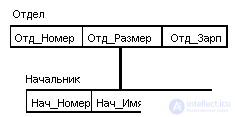Lecture
A typical representative (the most famous and common) is the IBM Information Management System (IMS). The first version appeared in 1968. Until now, many databases are supported, which creates significant problems with the transition to both new database technology and new technology.
A hierarchical database consists of an ordered set of trees; more precisely, from an ordered set of several instances of the same tree type.
A tree type consists of one “root” record type and an ordered set of zero or more subtree types (each of which is a certain tree type). A tree type as a whole is a hierarchically organized set of record types.
Example of tree type (hierarchical database schema):

Here A department is an ancestor for the Chief and Employees, and the Chief and Employees are the descendants of the Division. Relationships are maintained between record types.
A database with such a scheme could look like this (we show one instance of the tree):

All instances of this type of descendant with a common instance of the type of ancestor are called twins. For the database, the complete traversal order is defined - from top to bottom, from left to right.
IMS used the original and non-standard terminology: “segment” instead of “record”, and “record DB” was understood as the whole segment tree.
Examples of typical manipulation operators for hierarchically organized data include:
The integrity of links between ancestors and descendants is automatically maintained. The basic rule: no descendant can exist without its parent. Note that similar integrity maintenance by links between records that are not in the same hierarchy is not supported (an example of such an "external" link could be the contents of the Kaf_Number field in the Curator type instance).
In hierarchical systems, some form of database representation was supported based on hierarchy constraints. An example of the presentation of the above DB may be a hierarchy

Comments
To leave a comment
Databases IBM System R - relational DBMS
Terms: Databases IBM System R - relational DBMS